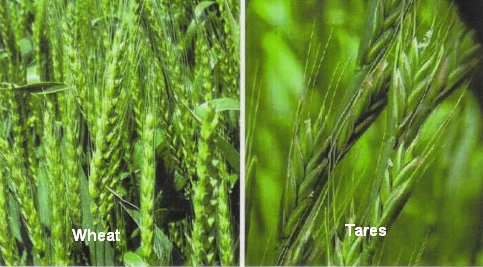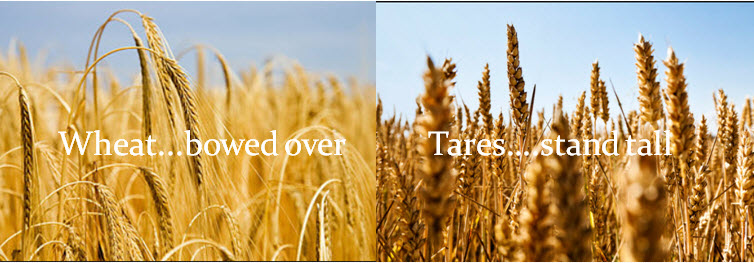One of my favorite parables, and probably one of the more well-known parables, is the parable of the wheat and the tares.
Here it is straight out of the good book.
Matthew 13:24-30, 36-43:
24 Another parable put he forth unto them, saying, The kingdom of heaven is likened unto a man which sowed good seed in his field:
25 But while men slept, his enemy came and sowed tares among the wheat, and went his way.
26 But when the blade was sprung up, and brought forth fruit, then appeared the tares also.
27 So the servants of the householder came and said unto him, Sir, didst not thou sow good seed in thy field? from whence then hath it tares?
28 He said unto them, An enemy hath done this. The servants said unto him, Wilt thou then that we go and gather them up?
29 But he said, Nay; lest while ye gather up the tares, ye root up also the wheat with them.
30 Let both grow together until the harvest: and in the time of harvest I will say to the reapers, Gather ye together first the tares, and bind them in bundles to burn them: but gather the wheat into my barn.
36 Then Jesus sent the multitude away, and went into the house: and his disciples came unto him, saying, Declare unto us the parable of the tares of the field.
37 He answered and said unto them, He that soweth the good seed is the Son of man;
38 The field is the world; the good seed are the children of the kingdom; but the tares are the children of the wicked one;
39 The enemy that sowed them is the devil; the harvest is the end of the world; and the reapers are the angels.
40 As therefore the tares are gathered and burned in the fire; so shall it be in the end of this world.
41 The Son of man shall send forth his angels, and they shall gather out of his kingdom all things that offend, and them which do iniquity;
42 And shall cast them into a furnace of fire: there shall be wailing and gnashing of teeth.
43 Then shall the righteous shine forth as the sun in the kingdom of their Father. Who hath ears to hear, let him hear.Interestingly, wheat and tares look almost identical while they are growing. It isn't until they reach maturity that you can easily distinguish between them. At maturity wheat bows its head while tares don't. The photos below help illustrate the parable.

“Traditionally, tares have been identified with the darnel weed, a species of bearded rye-grass which closely resembles wheat in the early growth period and which is found in modern Palestine. This weed has a bitter taste; if eaten in any appreciable amount, either separately or when mixed with bread, it causes dizziness and often acts as a violent emetic.” (McConkie, Doctrinal New Testament Commentary, 1:296.)" --Doctrine and Covenants Student Manual

I find it interesting that not only are tares weeds which resemble the crop but they are also toxic. Just like in the parable it's very difficult to distinguish the good from the bad in the Lord's church. And many of the bad even though they look the same as righteous members, are toxic.
It brings to mind the Women's March that just took place and members of the Church who participated. How can anyone who claims to be a disciple of Jesus Christ proudly participate in something so vile, obscene, vulgar and profane? Everything the Women's March stood for is not only incompatible with but directly opposed to the doctrines of the gospel of Jesus Christ. Tares.
"President Joseph Fielding Smith pointed out that “even in the Church the tares are to be found. It is the tares which are to be gathered up and burned from all over the world, but those in the Church will also be gathered out and find their place in the fire. [See D&C 112:23–26.] The Savior also bore witness of [this. When] speaking to the Nephites he said: ‘For it shall come to pass, saith the Father, that at that day whosoever will not repent and come unto my Beloved Son, them will I cut off from my people, O house of Israel.’ (3 Nephi 21:20.)” (Church History and Modern Revelation, 1:354.)"-- Doctrine and Covenants Student Manual
Another example is Jan C. no, let's call her J. Chamberlain. ;-) The former member of the Mormon Tabernacle Choir who resigned from the choir because the Choir had the audacity to accept an invitation to sing at a presidential inauguration.Which they had done before, regardless of party. Heaven forbid the choir, which represents the Church, does something patriotic and unifying. Yet she claims she was morally opposed to performing with the choir at the inauguration. Thank heavens she chose to quit instead of opting out of the lottery for those wanting to perform at the inauguration. Now I won't have to see her clown red hair in the choir anymore, which stuck out like a sore thumb. The last name says it all. Not to mention all the other Church members who were upset with the Mormon Tabernacle Choir for doing something patriotic, unifying, and good. Tares.
I could go on with endless examples of tares within the Church but suffice it to say, there are plenty.
Not only do the tares mimic the wheat, but growing side-by-side they steal nutrients from the wheat and because the roots are intermingled if you rip out the tares, you will also kill the wheat. If you're not careful the tares will challenge your faith and weaken your testimony. Which will eventually kill you spiritually.
We've all heard that phrase "be in the world but not of the world". The wheat and the tares must coexist until harvest. The righteous and wicked are all in the world-- and in the Church -- simultaneously. But the righteous wheat must not be of the world lest the wicked tares choke them out or poison them.
In Doctrine and Covenants Section 86 the Lord clarifies the parable of the wheat and the tares.
Doctrine and Covenants Section 86:
1 Verily, thus saith the Lord unto you my servants, concerning the parable of the wheat and of the tares:
2 Behold, verily I say, the field was the world, and the apostles were the sowers of the seed;
3 And after they have fallen asleep the great persecutor of the church, the apostate, the whore, even Babylon, that maketh all nations to drink of her cup, in whose hearts the enemy, even Satan, sitteth to reign—behold he soweth the tares; wherefore, the tares choke the wheat and drive the church into the wilderness.
4 But behold, in the last days, even now while the Lord is beginning to bring forth the word, and the blade is springing up and is yet tender—
5 Behold, verily I say unto you, the angels are crying unto the Lord day and night, who are ready and waiting to be sent forth to reap down the fields;
6 But the Lord saith unto them, pluck not up the tares while the blade is yet tender (for verily your faith is weak), lest you destroy the wheat also.
7 Therefore, let the wheat and the tares grow together until the harvest is fully ripe; then ye shall first gather out the wheat from among the tares, and after the gathering of the wheat, behold and lo, the tares are bound in bundles, and the field remaineth to be burned. -- Doctrine and Covenants 86: 1-7I think most people, when they think of this parable, think of it as wheat being members of the Lord's church, or the righteous, and tares being everyone else in the world, or the wicked. But, it also applies beautifully to members of the Church. The wicked and righteous people within the Church. As was discussed prior. Thus another example of how parables can have different interpretations and applications.
I could delve into all the beautiful symbolism in this parable but it would take much too long. I'll let you come to your own conclusions. It's a very beautifully written parable.
"In 1894 President Woodruff stated: “God has held the angels of destruction for many years, lest they should reap down the wheat with the tares. But I want to tell you now, that those angels have left the portals of heaven, and they stand over this people and this nation now, and are hovering over the earth waiting to pour out the judgments. And from this very day they shall be poured out. Calamities and troubles are increasing in the earth, and there is a meaning to these things. Remember this, and reflect upon these matters. If you do your duty, and I do my duty, we’ll have protection, and shall pass through the afflictions in peace and in safety.” (Young Women’s Journal, Aug. 1894, pp. 512–13.)" --Doctrine and Covenants Student Manual
That statement by the prophet at the time, President Wilford Woodruff, was given over 120 years ago. Yes, the harvest is very close. The Second Coming is nigh at hand. Do not procrastinate the day of your repentance. Prepare now lest you be burned with the tares at the harvest. Yet if you are prepared and are doing your best to live the Gospel of Jesus Christ and keep His commandments then you have no need to fear. The harvest will come. The tares will be gathered and burned while the wheat will be gathered into the Lord's barn. Will you be amongst the wheat or the tares at the harvest?
That's my two cents.
Another great post, Tam.
ReplyDeleteI like the visual also, showing the similarities of the wheat and the tares. It is crazy how similar they look.
Nice quote by Pres. Woodruff-"...those angels have left the portals of heaven, and they stand over this people and this nation now, and are hovering over the earth waiting to pour out the judgments..." The harvest is closer than many like to believe. Really exciting, if you ask me.
I want to be harvested with the wheat please. Plenty people in my own ward who are tares.
ReplyDelete